Tea Insect Pests
Tea Insect Pests
Tea mosquito bug
Biology- Egg: The eggs are elongated and sausage shaped. Each egg bears two C filamentous processes which project out from the tissues in which the eggs have been inserted Hatching occurs within 5 to 7 days in summer and 20 to 27 days m winter.
- Nymph: The nymph bears delicate, elongated legs. The dirty-yellow nymphs suck the sap of the host plant and undergo five moults to attain maturity. The larval period lasts for 9-10 days in summer and 25-29 days in winter.
- Adult: The adult H. theivora is small bug measuring 6-8 mm in length. The body is slender and elongated with yellowish-brown or olive green head, dark red thorax and yellow and greenishblack abdomen. Appendages are long, dark and delicate. The thorax bears a characteristic dorsal knobbed process. Life cycle is completed in about 15 20 days in summer and 45-60 days in winter in North-East Indian conditions. There may be several generations in a year.
Life cycle
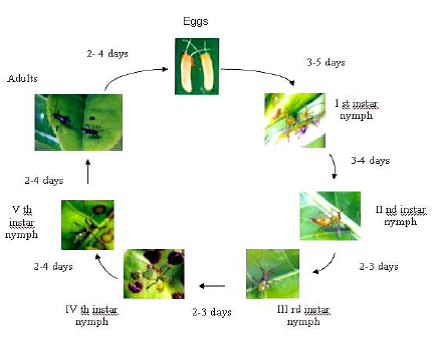
Damage symptoms
- The nymphs and adults suck the sap of the young leaves, buds
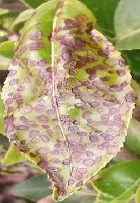 and tender stems and while doing so, they injects toxic saliva which causes the breakdown of tissues around the site of feeding.
and tender stems and while doing so, they injects toxic saliva which causes the breakdown of tissues around the site of feeding. - Within 2-3 hours of sucking a circular spot is formed around the feeding point and in 24 hours it becomes translucent, light browning. Within a few days the spots appear as dark brown sunken spots which subsequently dry up. The badly affected leaves become deformed and even curl-up.
- In addition, due to oviposition, the tender stems develop cracks and over-callusing which lead to blockage of vascular bundle thereby affecting the physiology causing stunted growth and sometimes die-back of the stems
- Parasitoids: Mymarid, Erythmelus helopeltidis.
- Predators: Chrysoperla zastrowii sillemi, Mallada sp, Oxyopes sp. (Spider), Reduviid bug Praying Mantids.
- Pathogens: Nematodes (Hexamermis sp.) Beauveria bassiana.
Thrips
Biology- Egg: The egg is bean-shaped, slightly narrower at one end and is almost colourless when freshly laid.
- Nymph: The newly hatched nymph is almost white but soon after sucking of plant sap, the colour gradually changes to pale yellow. The second instar nymph is orange yellow .
- Pre-pupa: The pre-pupa can be recognized by the free antennae directed forward while in the pupa; the antennae are reflected over the head to reach the middle of the pro-thorax.
- Adult: The adult insect is pale yellow in colour, the abdomen being paler. The female measures 1.05 mm long and 0.19 mm width. The male measures 0.71 mm in length and 0.14 mm in width.
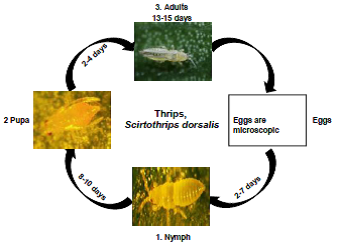
- Feeds on tender above ground parts, creating feeding scars, distortion of leaves and discoloration of buds
- The infested leaves curl upward, crumble and shed
- Infested buds become brittle and drop down.
- The sucking marks are made one after one, forming thin pale lines on the underside of leaves parallel to the main vein
S. dorsalis is found in almost all chilly growing areas. It is a polyphagus pest. Besides chilli, it also infests brinjal, cotton, groundnut, castor, bottlegourd, guava, tea and grapevine. It is more common on un-irrigated chilli crop than irrigated one.
Natural enemies of thrips- Predators:Anthocoris and Orius spp., predatory thrips (Aeolothrips intermedius, Mymarothrips garuda), Chrysoperla carnea, Mallada sp, praying mantids, ladybird beetles, syrphid flies, spiders etc.
- Pathogens: Steinernema sp., Verticillium lecanii, Beauveria bassiana, Metarhizium anisopliae, Paecilomyces fumerosus
Leaf eating caterpillar
Biology- Egg: Female lays about 300 eggs in clusters. The eggs are covered over by brown hairs and they hatch in about 3-5 days.
- Larva: Caterpillar measures 35-40 mm in length, when full grown. It is velvety, black with yellowish – green dorsal stripes and lateral white bands with incomplete ring – like dark band on anterior and posterior end of the body. It passes through 6 instars. Larval stage lasts 15-30 days.
- Pupa: Pupation takes place inside the soil, pupal stage lasts 7-15 days.
- Adult: Moth is medium sized and stout bodied with forewings pale grey to dark brown in colour having wavy white crisscross markings. Hind wings are whitish with brown patches along the margin of wing. Pest breeds throughout the year. Moths are active at night. Adults live for 7-10 days. Total life cycle takes 32-60 days. There are eight generations in a year.
Life cycle
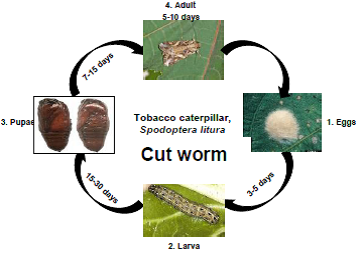
Damage symptoms
- In early stages, the caterpillars are gregarious and scrape the
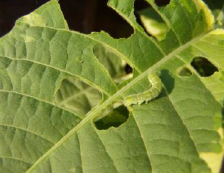 chlorophyll content of leaf lamina giving it a papery white appearance. Later they become voracious feeders making irregular holes on the leaves.
chlorophyll content of leaf lamina giving it a papery white appearance. Later they become voracious feeders making irregular holes on the leaves. - Irregular holes on leaves initially and later skeletonisation leaving only veins and petioles
- Heavy defoliation.
Natural enemies
- Parasitoids:Trichogramma chilonis, Tetrastichus spp., Telenomus spp., Ichneumon promissorius, Carcelia spp, Campoletis chlorideae, Lissopimpla excels, Ichneumon promissorius etc.
- Predators: Chrysoperla zastrowi sillemi, coccinellids, King crow,braconid wasps, dragonfly, spider, robber fly, reduviid bug, praying mantis, and red ants etc.
Jassid
Biology- Egg: Adult females lay eggs along the midrib and lateral veins of the leaves. The egg period is 4 to 11 days.
- Nymph: The nymphs resemble the adults, but lack wings. Instead, they have slightly extended wing pads. They are pale green in color. They tend to move sideways when disturbed. The nymphal period varies from 1-4 weeks depending on the temperature.
- Adult: The adults are wedge-shaped, pale green insects. They have fully developed wings with a prominent black spot on each forewing. The adults may live for one to two months.
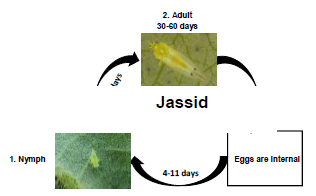
- Both nymphs and adults suck the sap from the lower leaf surfaces through their piercing and sucking mouthparts. While sucking the plant sap, they also inject toxic saliva into the plant tissues, which leads to yellowing. When several insects suck the sap from the same leaf, yellow spots appear on the leaves, followed by crinkling, curling, bronzing, and drying, or “hopper burn”. Leafhoppers also cause damage in okra, cotton, and potato seriously.
- Parasitoids: Anagrus flaveolus, Stethynium triclavatum
- Predators: Ladybird beetle, ants Distina albino, Chrysoperla spp., mired bug (Dicyphus hesperus), big-eyed bug, (Geocoris sp) Praying mantids.
Aphids
Biology- Egg: are very tiny, shiny-black, and are found in the crevices of bud, stems, and barks of the plant. Aphids usually do not lay eggs in warm parts of the world.
- Nymph: (immature stages) are young aphids; they look like the wingless adults but are smaller. They become adults within 7 to 10 days.
- Adult: are small, black to dark brownish colour, 1 to 4 mm long, soft-bodied insects with two long antennae that resemble horns. Most aphids have two short cornicles (horns) towards the rear of the body.
Life cycle
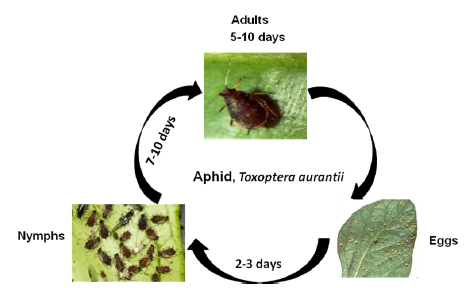
Damage symptoms
- Nymphs and adults suck cell sap from
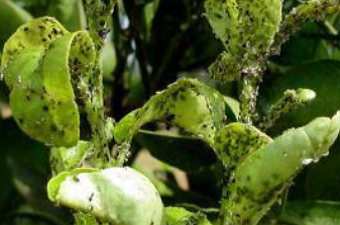 the plant foliage.
the plant foliage. - In addition, plants may become contaminated by honeydew produced by aphids and sooty mould growing on honeydew.
- Aphids are also vectors of diseases, including the bean common mosaic virus.
- Parasitoids: Aphidius colemani, Aphelinus sp and Diaeretiella sp.
- Predators: Fire ant, Robber fly, Big-eyed bug (Geocoris sp), Earwig, Ground beetle, Cecidomyiid fly, Lacewing, Ladybird beetle, Spider, Praying Mantis, Reduviid, Dragon fly, hoverfly.
Bunch caterpillar
Biology- Egg: The eggs are yellowish and are arranged in linear order by the female moth. A single female laid about 500 eggs.
- Larva: Within 7 to 11 days (in summer) caterpillars hatches out from the eggs. After emergence the caterpillars, first of all, feeds upon their egg shell, then they lacerate the leaf surface tissues and finally consume the whole leaf blade. The caterpillars remain clustered in characteristic bunches and hence are called “bunch caterpillars”. The gregarious nature of caterpillars continues throughout the larval life. During 3 to 4 weeks of larval life the larvae undergoes five instars. The fully grown and well fed matured larva measures about 65 mm in length. The larva is tawny-yellow with reddish tinge and broad blackish-brown transverse strips.
- Pupa: For pupation the larvae descend down from the host plant and pupate on the ground among dried leaves. The pupal period varies in different season. In summer it is 16 to 29 days, in rainy season it is about 46 days and in winter it is 68-120 days. The pupa is reddish-brown in colour and about 25 mm in size. There are four overlapping generations in a year in northeastern region of India.
- Adult: The adult moth is brown in colour. The wing span of male moth ranges from 33 to 45 mm, whereas in female it is 45-58 mm. Dark wavy lines are present on the wings. Fore wings have two white spots near the outer margin. The hind wings are brown posteriorly and pale in anterior region. The antennae are bipectinate but as compared to females the males have more developed and highly bipectinate antennae.
Life cycle
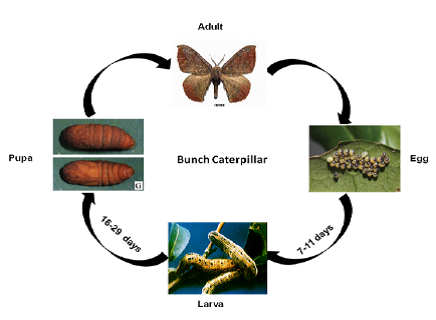
Damage symptoms
- The damage is caused to the host plant by the caterpillars. The caterpillars eat the foliage of the host plant. Initially, they feed upon the surface tissues only but later on the whole blade is consumed.
- The caterpillars move in groups and before going down for pupation a bunch of caterpillars may destroy several bushes of tea plantation.
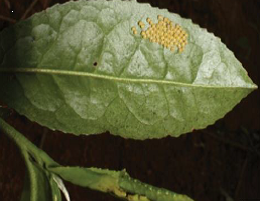
Natural enemies of bunch caterpillar
Larval Parasitoids: Tachinid fly, Cylindromyia sp., Cotesia ruficrus
Red spider mite
Biology- Egg: Eggs reddish, spherical, provided with a small filament. Incubation period is 4-6 days, before hatching becomes light orange colour.
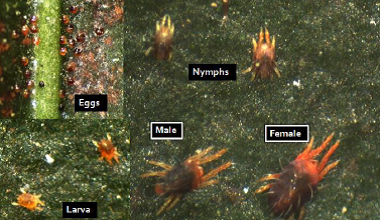
- Nymph: Upon hatching, it will pass through a larval stage and two nymphal stages before becoming adult. Developmental stages include six legged larva, protonymph and deutonymph.
- Adult: Adult female elliptical in shape, bright crimson anteriorly and dark pruplish brown posteriorlym. Mites spin a web of silken threads on the leaf. Each developmental stage is followed by a quiescent stage and life cycle completed in 10-14 days.
- Spider mites usually extract the cell contents from the leaves using their long, needlelike mouthparts. this results in reduced chlorophyll content in the leaves, leading to the formation of white or yellow speckles on the leaves.
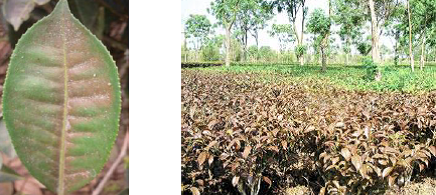
- In severe infestations, leaves will completely desiccate and drop off. The mites also produce webbing on the leaf surfaces in severe conditions. Under high population densities, the mites move to using strands of silk to form a ball-like mass, which will be blown by winds to new leaves or plants, in a process known as “ballooning.”
Predators: Predatory mite, Predatory thrips, Oligota spp., Orius sp (pirate bug), Hover flies, Mirid bug.
Purple mite
Biology- Egg: Eggs hatches in 2-3 days.
- Nymph: There are two nymphal stages and they are white in colour, young ones moult three times.
- Adult: Adults are very small, spindle shaped, purple colour; fringed body with five longitudinal white waxy ridges on dorsal side, total developmental period was 6-11 days
- Damaged leaves characterized by the coppery brown discoloration; presence of numerous white cast skins of the mites along with the live mites; purple mites are prevalent on the under surface of mature leaves
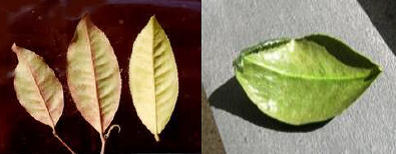
Pink mite
Biology- Egg: Eggs are shiny, globular in shape and lay singly on the under surface of the leaves. Eggs are hatch in 2-3 days
- Nymph: There are two nymphal stages and they are white in colour. Population builds up initiates in November/December and attains peak in February/March and declined during May/June. Life cycle completed in 6-9 days.
- Adults: Adults are very small, spindle shaped, pink colour; fringed body with five longitudinal white waxy ridges on dorsal side, young ones moult three times; incubation period ranges 3-5 days with two nymphal stages while total developmental period was 6-11 days.
- Important mite pest of tea in southern India causes considerable damage. During early stages of attack leaves turn pale and curl upwards while severe infestation leads to brownish discolouration. Pink mites attack tender crop shoots where “Aassam” hybrids are more susceptible Predators same as red spider mite
Yellow mite
Biology- Egg: Eggs are oval shaped and white in colour. Eggs are glued firmly on the leaf surface. Eggs large, obovate, flattened at the bottom; eggs hatches after 27-32 hours
- Nymph: Nymphs white in colour.
- Adult: Adults large, oval and broad and yellowish in colour. Females are yellowish and bigger than the males and they carrying the “female nymphs” on their back.
Life cycle
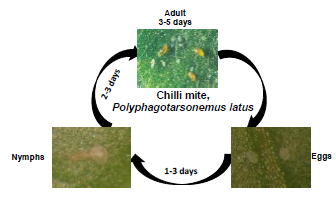
Damage symptoms
- Mite is seen on young leaves especially t
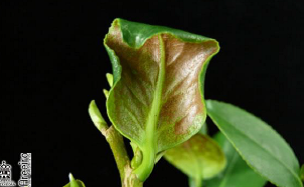 he top two to three leaves and the bud.
he top two to three leaves and the bud. - Affected leaves become rough and brittle and corky lines.
- Downward curling.
- Internodes get shortened.
Scarlet mite
Biology- Egg: Eggs are bright red, elliptical, laid in clusters; incubation period is 7-10 days.
- Nymph: Developmental stages include three legged larva, protonymph and deutonymph and each developmental stage is followed by a quiescent stage.
- Adult: Adult mite is scarlet red in colour and obovate in shape; reproduction is by parthenogenesis. Life cycle completed in 30-36 days.
Life cycle
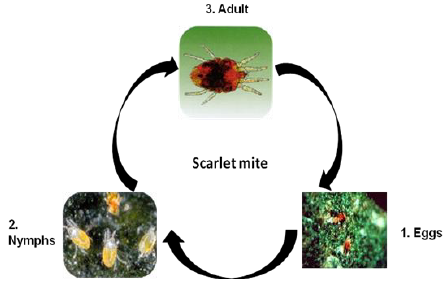
Symptoms of damage
- Symptoms of attack first appear on either side of the midrib and gradually spread to the entire leaf; feeding leads to brown discolouration of leaves and severe infestation leads to defoliation.
Root knot nematode
Biology
- Most species of plant parasitic nematodes have a relatively simple life cycle consisting of the egg, four larval stages and the adult male and female.
- Development of the first stage larvae occurs within the egg where the first molt occurs. Second stage larvae hatch from eggs to find and infect plant roots or in some cases foliar tissues.
- Under suitable environmental conditions, the eggs hatch and new larvae emerge to complete the life cycle within 4 to 8 weeks depending on temperature.
- Nematode development is generally most rapid within an optimal soil temperature range of 70 to 80°F.
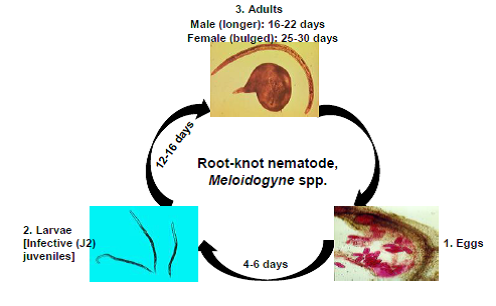
Damage symptoms
- Infected plants in patches in the field
- Formation of galls on host root system is
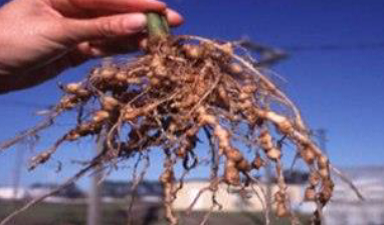 the primary symptom
the primary symptom - Roots branch profusely starting from the gall tissue causing a ‘beard root’ symptom
- Infected roots become knobby and knotty
- In severely infected plants the root system is reduced and the rootlets are almost completely absent. The roots are seriously hampered in their function of uptake and transport of water and nutrients
- Plants wilt during the hot part of day, especially under dry conditions and are often stunted
- Nematode infection predisposes plants to fungal and bacterial root pathogens
- Primary: Egg masses in infected plant debris and soil or collateral and other hosts like Solonaceous, Malvaceous and Leguminaceous plants act as sources of inoculums.
- Secondary: Autonomous second stage juveniles that may also be water dispersed.
Loamy light soils.
IPM for Tea
To know the IPM practices for Tea, click here.
Source:NIPHM; Directorate of Plant Protection, Quarantine & Storage
Last Modified : 4/2/2020
This topic provides information about Cherry- Inse...
This topic covers information about Chilli insect...
This topic covers information about Description of...
This topic covers information about Fenugreek Ins...
